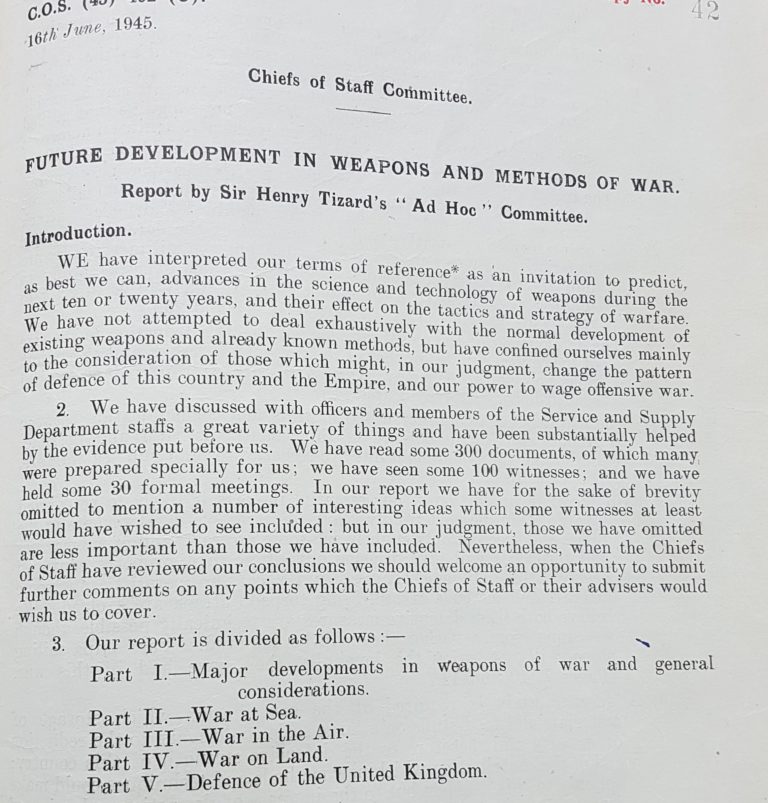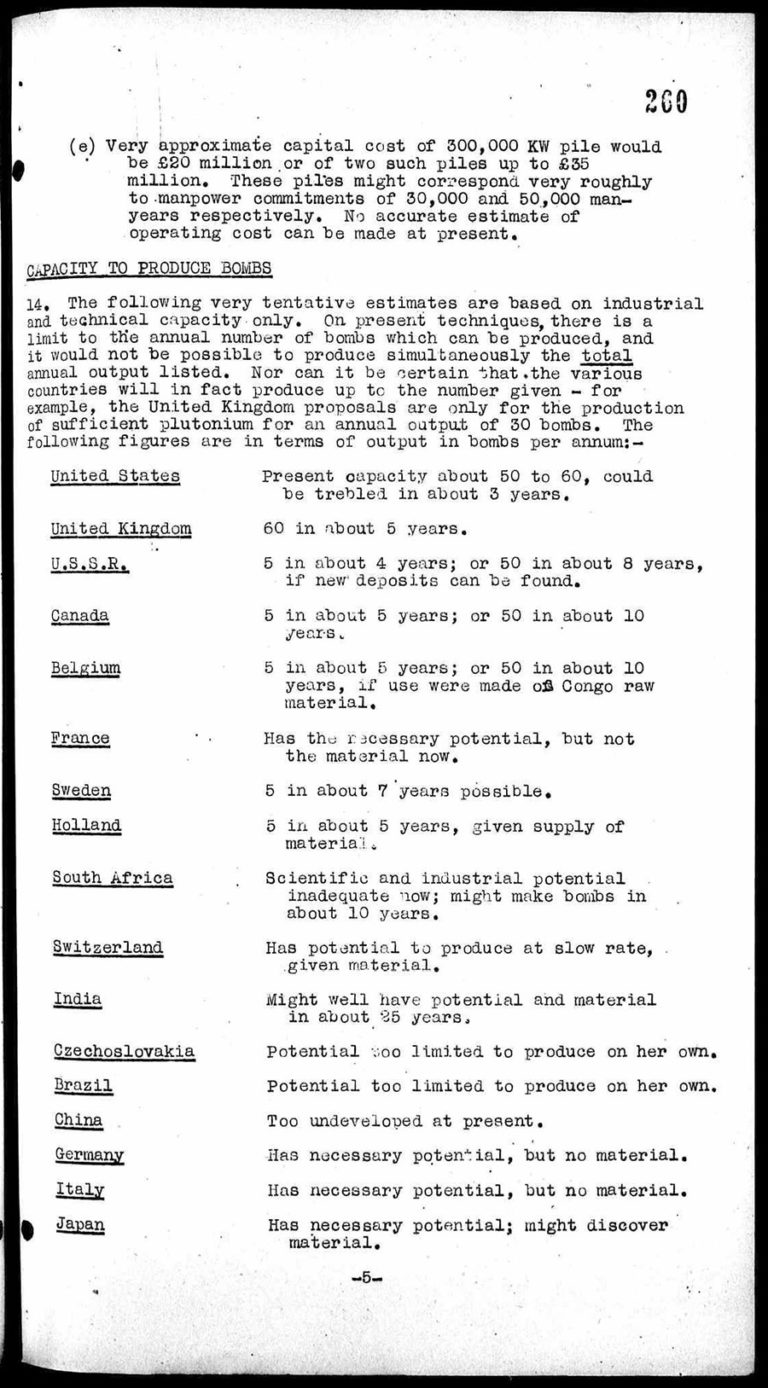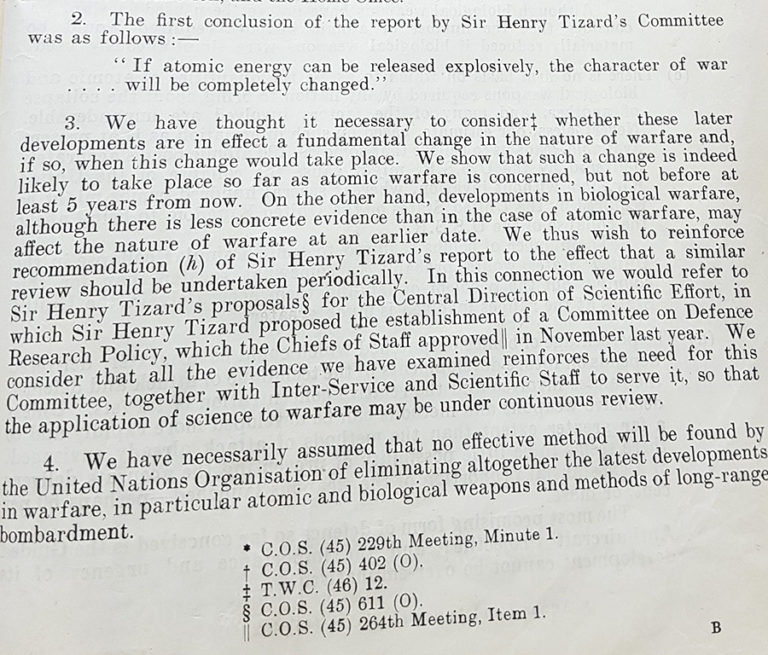On 28 August 1945, the newly elected British Prime Minister, Clement Attlee, authored a memorandum on the atomic bomb for the attention of his Cabinet. In it he declared that the United Kingdom and the United States of America ‘are responsible as never before for the future of the human race’ and that he believed that ‘only a bold course can save civilisation’ (CAB 130/3).
A month later, he wrote to Harry Truman, the President of the United States, offering similar sentiments. In his letter he stated that:
‘Ever since the USA demonstrated to the world the terrible effectiveness of the atomic bomb I have been increasingly aware of the fact that the world is now feeling entirely new conditions…The emergence of this new weapon has meant, taking account of its potentialities, not a quantitative but a qualitative change in the nature of warfare’ (CAB 130/3).
He went on to say that, as a result, the great powers were left with decisions to make that were vital not just to the increase of human happiness, ‘but to the very survival of civilisation’. Documents available at The National Archives uncover just how the British authorities were attempting to plan for the future, and were particularly interested in assessing the future of warfare.

In June 1945, Sir Henry Tizard’s report on the ‘Future Development in Weapons and Methods of War’ was presented to ministers and officials. Tizard, who had been instrumental in the development of radar and also led the British Technical and Scientific Mission to the United States (known as the Tizard Mission), which had been tasked to obtain the industrial resources required to exploit military developments made by Britain, had formed an ad hoc committee to look into the issue of the future of war.
After consulting 300 documents, speaking to 100 witnesses, and organising 30 formal meetings, it sought to predict advances in science and technology for the following 10 to 20 years. The report’s main conclusion related to the potential of atomic bombs, pointing out that ‘the practical achievement of the release of atomic energy is likely to bring about an industrial revolution and have an immense influence on technology in peace and war’. The authors went on to say that the energy involved in the dropping an atomic bomb is two million times that released by TNT, meaning that a single bomber could do damage equal to that of 1,000 bombers dropping normal bombs. The report concluded, quite confidently, that the use of atomic energy in peace and war ‘is only in its very infancy’ (DEFE 2/1251).
Within months, atomic bombs had been dropped by US bombers on Hiroshima and Nagasaki in Japan and, as might be expected, this caused a radical reassessment of the situation. By December 1945, a meeting of the British military Chiefs of Staff Committee reported that no fewer than 17 nations had the potential to develop atomic weapons, primarily because the material necessary was located nearby or within their colonies. It was concluded that the United States, which already had an annual production of 50 bombs, would probably be in a position to manufacture 300 bombs per year by the end of 1950. The feeling was that Britain, in conjunction with Canada, could achieve an output of 60 bombs per year by 1950, while their closest rival, the USSR, would be in a position to produce 50 bombs per year by 1953 (CAB 79/42/10).

As a result of the rapidly changing environment, Tizard’s Committee was required to update its report, and was not in a position to present its findings until July 1946. The conclusion was that the nature of warfare would not likely change for at least five years, but, when it did, if 5-10 bombs landed on a target, this would cause the evacuation of cities to an extent ‘sufficiently seriously to sap the power of waging war by conventional means of any country physically or psychologically unorganised to meet such action’ (DEFE 2/1252).
The Committee estimated that if between 30 and 120 atomic bombs were delivered accurately by the USSR, it would cause the collapse of the UK without an invasion. In contrast, the belief was that it would take ‘several hundred bombs’ delivered by the United States and UK in conjunction, to bring about the collapse of the USSR.

After having conducted extensive studies of Hiroshima and Nagasaki, it was estimated that if an atomic bomb was dropped on Britain, it would destroy 50% of an area over a three square mile built-up area. That would mean the destruction of 30,000 dwellings, the deaths of 25,000 people, and permanent displacement of 175,000. It went on to say that British Civil Defence had to be drastically improved, that medical services required a reorientation and strengthening to meet the demands of change, and concluded that ‘it appears to us that the change in the nature of war will be far-reaching in its implications both on the armed forces and on the lives of those the armed force must be designed to defend’ (DEFE 2/1252).
As is to be expected, those at the top were giving serious consideration to the issue in which Britain and the wider world found itself. The records point to an early consideration of ‘mutually assured destruction’ (MAD), the method of deterrence, threatening to use certain weapons against an enemy so that they will not use them against you. Though, at this early stage, Attlee seemed unsure of this policy and feared the worst for the world’s population, concluding his letter to Truman that ‘until decisions are taken on this vital matter, it is very difficult for any of us to plan for the future’.
Fascinating insight into the eary atomic years thanks for sharing
Appalling that Britain could contemplate the destruction of vast numbers of civilians and the injuries that were caused by atomic bombs. The testing of Britain’s nuclear bombs at Maralinga, Australia, is a case of modern racism since the area was Aboriginal land and our home nuclear sites were put in Scotland, not England. Some of the countries like The Netherlands would I am sure never have had atomic bombs, they tried during the World Wars to be neutral. Some of the assumptions by Government were ridiculous about life continuing after a nuclear attack and makes you wonder that even in the 1960s whether they were living in a dream world.